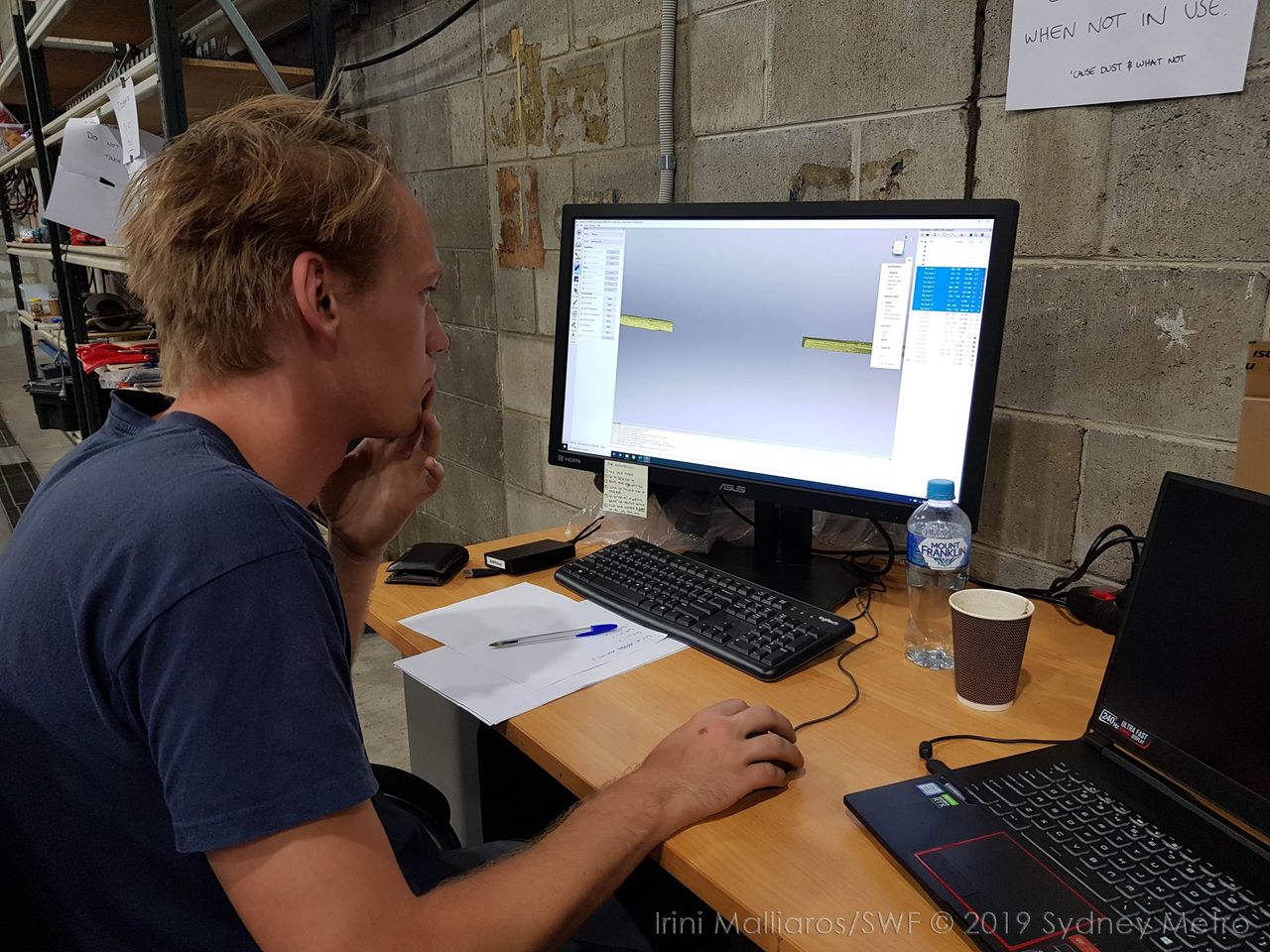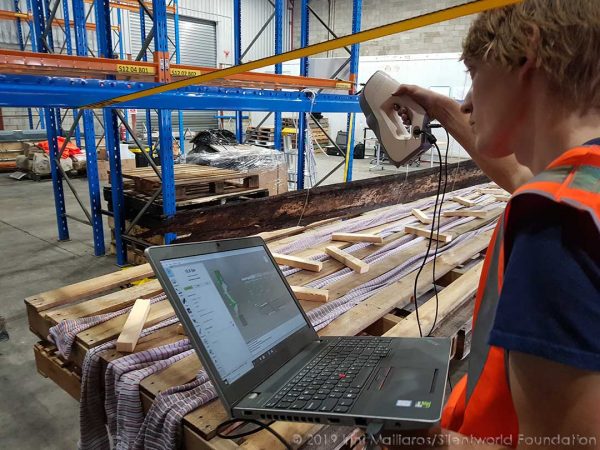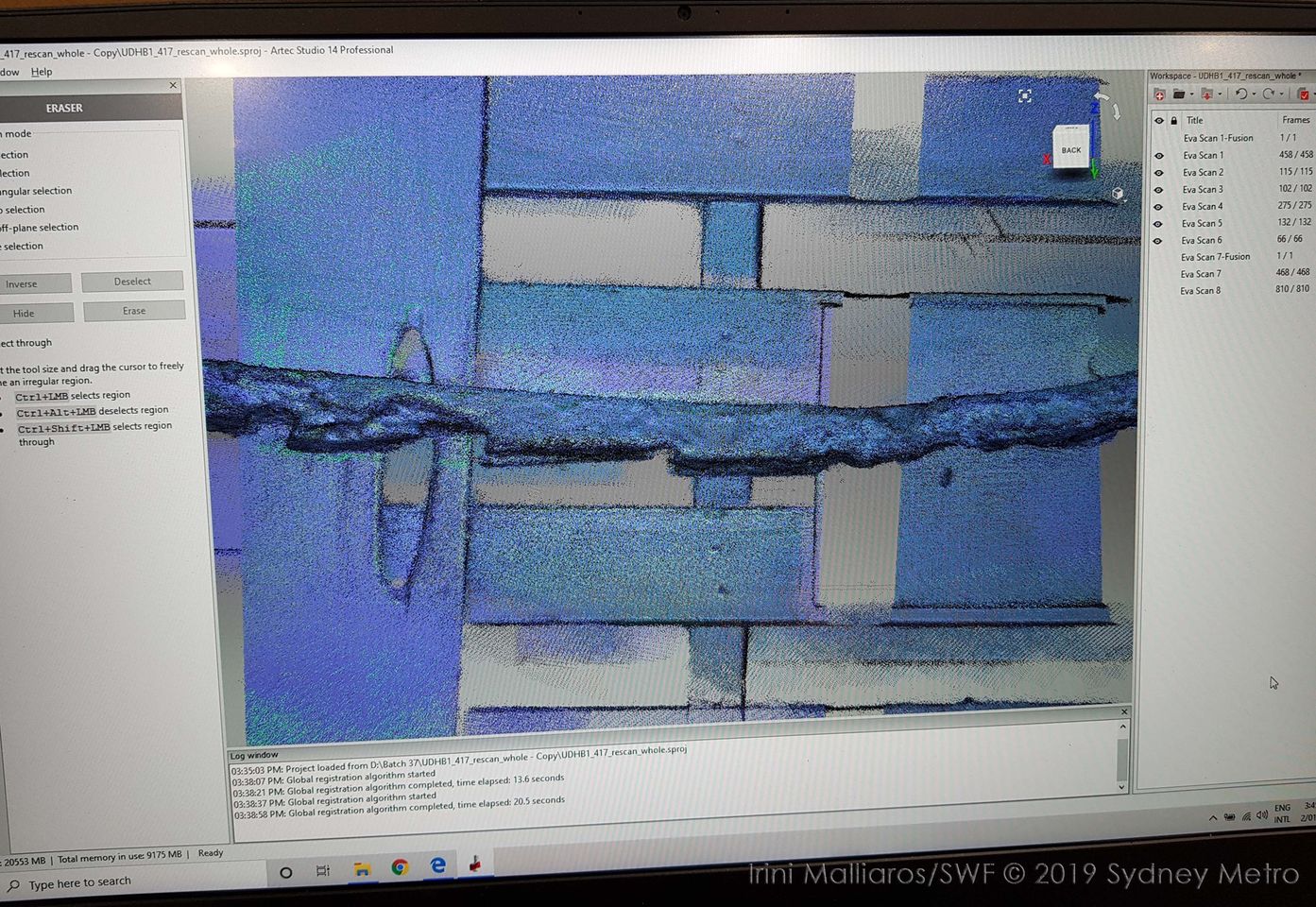In November 2018, the well-preserved remains of a boat were unearthed during an excavation at the Barangaroo railway station in Sydney, Australia. The fascinating discovery became one of the most important in Sydney maritime history, considering it was the first Australian-built European boat made with autochthonous timber ever to be excavated. Recorded in such high detail and fully conserved, the finding has undergone an intricate preservation process, including detailed 3D scannings to record each ship’s timber in high resolution and 3D digital models. The team of scientists behind the conservation of the Barangaroo Boat, as it is now known, is also getting ready to 3D print a model for display in the Australian National Maritime Museum.
 Maritime archaeologist Cosmos Coroneos with the 180-year-old timber boat uncovered during excavation works for a new Sydney Metro station. Image courtesy of Sydney Metro.
Maritime archaeologist Cosmos Coroneos with the 180-year-old timber boat uncovered during excavation works for a new Sydney Metro station. Image courtesy of Sydney Metro.At nine meters long, three meters wide, and at least one meter deep, the 19th Century Barangaroo Boat has the potential to reveal rare information on colonial shipbuilding techniques and the adaptive use of native Australian timber in European construction traditions. The rare discovery was excavated and painstakingly recorded on-site before being methodically dismantled from its resting place.
All timbers were carefully wrapped and stored in refrigerated containers to slow and prevent biological activity. At the time of the finding maritime archaeologist, Cosmos Coroneos noticed that there was still a lot to learn about the vessel. So to conserve all the timbers, a team of scientists and experts from the Australasian maritime archeology organization Silentworld Foundation started a project to professionally document and conserve the boat hull structural elements. Led by the foundation’s program director and maritime archaeologist Irini “Renee” Malliaros, the team had to follow a sequence of steps to remove the timbers from their cold storage, record them in detail, prepare them for treatment and finally place them in tanks for conservation.
 Irini “Renee” Malliaros recording the timber of the Barangaroo Boat using 3D scanning. Image courtesy of Silentworld Foundation/Sydney Metro.
Irini “Renee” Malliaros recording the timber of the Barangaroo Boat using 3D scanning. Image courtesy of Silentworld Foundation/Sydney Metro.One of the biggest challenges was finding a way to digitally record the boat and recreate it while the original one is prepared for display. During this phase, the Silentworld Foundation and Sydney Metro team (in charge of the fully automated rapid transit system built at the discovery site) worked with the UK’s York Archaeological Trust and Belgian 3D scanning company Ubi3D.
The team worked closely with Ubi3D founder Thomas Van Damme, the 3D scanning specialist who focuses on the application and development of 3D recording tools and workflows for maritime archaeological research, documenting shipwreck sites and ship timber assemblies and teaching 3D recording. The expert has developed a new approach to ship timber recording called the “3D annotated scans method,” which consists of a 3D scanning phase of the timber, followed by a 3D annotation phase in which the recorder interprets the timber by tracing diagnostic features such as fasteners and toolmarks directly onto the timber’s digital model.
The method was introduced in Australia during the recording of the Barangaroo Boat timbers, with Van Damme even training fellow researchers to combine structured light scanning and the CAD software Rhino. Malliaros has described the experience as “the future of recording in heritage.”
 Thomas Van Damme preparing the 3D scanning process for the Barangaroo Boat timber. Image courtesy of Silentworld Foundation/Sydney Metro.
Thomas Van Damme preparing the 3D scanning process for the Barangaroo Boat timber. Image courtesy of Silentworld Foundation/Sydney Metro.Unlike the current methods used for ship timber recording, namely 2D scaled drawing, 2D tracing, 3D contact digitizing, and 3D scanning, the new 3D annotated scans method for ship timber recording can also be used for a wide range of heritage applications as well. This unique workflow for scanning and annotating 3D meshes uses the modeling software Rhino. During the annotation process, researchers go back and forth between examining the physical timber and then tracing all significant features onto the digital copy of the timber. In the end, the 3D annotated scans method consists of a digital 3D record containing both an objective digital copy of the timber and the archaeologist’s interpretation of that timber layered on top.
The new approach to heritage recording allows for efficient, accurate, and detailed 3D documentation and interpretation and streamlined 2D visualization. Once the excavated timbers were cleaned for the Barangaroo Boat, each timber was individually scanned with the Artec 3D scanner and processed, ready for annotation in Rhino. According to the Silentworld Foundation, this is the highest possible recording level and will be most useful in the reconstruction phase of the project.
 Thomas Van Damme during the 3D scanning process for the Barangaroo Boat timber. Image courtesy of Silentworld Foundation/Sydney Metro.
Thomas Van Damme during the 3D scanning process for the Barangaroo Boat timber. Image courtesy of Silentworld Foundation/Sydney Metro.Scanning the frame elements of the Barangaroo Boat faced a few challenges that Van Damme could address quickly and easily. The slightly larger problem to solve was scanning the planks, so the experts had to devise a way to capture the most information and reference geometry that would help the software reconstruct what the camera was capturing.
Suspending the planks with several soft plastic tubes over a “busy landscape” proved the most effective. Once the structured light scanner captured the raw scans of the shipwreck timbers, they were processed to produce teach timber’s final, clean 3D model. The process included lining up scans of different sides of the object, removing the surrounding reference geometry, getting rid of any “noise,” and applying the texture.
 Thomas Van Damme used his own 3D scanning/modeling technique to record the Barangaroo Boat’s shipwreck timbers. Image courtesy of Silentworld Foundation/Sydney Metro.
Thomas Van Damme used his own 3D scanning/modeling technique to record the Barangaroo Boat’s shipwreck timbers. Image courtesy of Silentworld Foundation/Sydney Metro.During a Silentworld Foundation live online panel, Malliaros said the new recording method allowed her to look at the 3D models in Rhino and the timber simultaneously. “We had created layers that we could turn on and off and note patterns. When we look at the timber, it is difficult to note where all the nail holes are because they are so small or where the tool marks are because archaeological wood is so dark. So by drawing and highlighting them, it allows us to extract patterns. That way, we can build a more detailed picture of how the vessel was build and gives us a really good base to think about what the tradition was like in early colony times.”
 Thomas Van Damme used his own 3D scanning/modeling technique to record the Barangaroo Boat’s shipwreck timbers. Image courtesy of Silentworld Foundation/Sydney Metro.
Thomas Van Damme used his own 3D scanning/modeling technique to record the Barangaroo Boat’s shipwreck timbers. Image courtesy of Silentworld Foundation/Sydney Metro.According to Malliaros, before work starts on the actual pieces of the boat, there will be a practice run to see how all the pieces will fit together and what kind of support cradle system will be needed. For this to happen, scale versions of every single piece need to be 3D printed from the 3D models before reassembly of the timbers begins in the gallery space. “There will be a little scaled-down jigsaw puzzle version of the boat, and once that is put together – Cool! Now, to do it for real,” the expert explained to media site Metrology News.
Subscribe to Our Email Newsletter
Stay up-to-date on all the latest news from the 3D printing industry and receive information and offers from third party vendors.
You May Also Like
3D Printing Unpeeled: New Arkema Material for HP, Saddle and Macro MEMS
A new Arkema material for MJF is said to reduce costs per part by up to 25% and have an 85% reusability ratio. HP 3D HR PA 12 S has been...
3D Printing News Briefs, January 20, 2024: FDM, LPBF, Underwater 3D Printer, Racing, & More
We’re starting off with a process certification in today’s 3D Printing News Briefs, and then moving on to research about solute trapping, laser powder bed fusion, and then moving on...
3D Printing Webinar and Event Roundup: December 3, 2023
We’ve got plenty of events and webinars coming up for you this week! Quickparts is having a Manufacturing Roadshow, America Makes is holding a Member Town Hall, Stratafest makes two...
Formnext 2023 Day Three: Slam Dunk
I’m high—high on trade show. I’ve met numerous new faces and reconnected with old friends, creating an absolutely wonderful atmosphere. The excitement is palpable over several emerging developments. The high...































